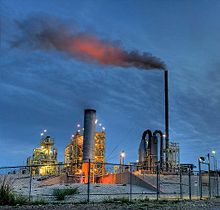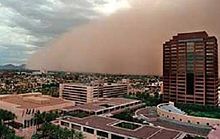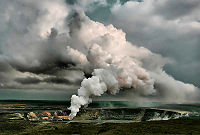Air pollution emissions
 From Citizendium - Reading time: 4 min
From Citizendium - Reading time: 4 min
- See Air pollution and Pollutant for related information
Air pollutant emissions ( commonly referred to as simply emissions) is the term used to describe any gases, liquid droplets and solid particulates which are emitted or discharged into the atmospheric air and adversely affect the health of humans, animals, ecosystems or the usefulness of a natural resource.[1][2]
The sole focus of this article is to define the term "air pollutant emissions" and to identify and discuss the anthropogenic and natural sources of air pollutant emissions. It is not intended to discuss the specific chemicals and other substances that are designated as air pollutants, the health effects of air pollution, the governmental regulations for controlling and limiting the emissions of air pollutants or the available technologies for reducing air pollution emissions.
Sources air pollutant emissions[edit]
- See Gallery subpage for additional photographs
The sources of air pollutant emissions can be categorized as:
Anthropogenic emission sources, meaning that they are a result of human activities, include:
- Stationary point sources: A stationary point source is a single, identifiable source of air pollutant emissions. For example: the emissions from a combustion furnace flue gas stack.
- Mobile sources: Mobile sources include the exhaust emissions from vehicles driven by fuel-burning engines. For example: automobiles, trucks, buses, trains, marine vessels, airplanes, etc.
- Area sources: An area source is a two-dimensional source of diffuse air pollutant emissions (for example, the emissions of methane and ammonia from piggeries and other livestock operations).
- Evaporative sources: Evaporative sources are volatile liquids that, when not completely enclosed in a tank or other container, evaporate and release vapors over time. For example: liquids such as paints, solvents, pesticides, perfumes, hair sprays, aerosol sprays and gasoline.
- Controlled burns: Controlled burning is a useful technique practiced in forestry management and in agriculture. Such controlled burns result in the formation and release of smoke, ash, dust, carbon dioxide, nitrogen oxides and other air pollutants.
- Waste disposal landfills: Microbes and chemical reactions act upon the waste and generate landfill gas that contains methane and carbon dioxide as well as small amounts of ammonia, mercaptans and other sulfides. Eventually, that gas escapes from the landfill and is released into the atmosphere.
Natural sources, meaning that they are not a result of human activities, include:[3]
- Volcanoes: Volcanic activity produces smoke, ash, carbon dioxide, sulfur dioxide and other air pollutants.
- Geysers: The air pollutants emitted by geysers include hydrogen sulphide, arsenic and other heavy metals.
- Digestive gases: Methane and other gases generated by the digestion of food and emitted by animals such as cattle.
- Oceans, Rivers and Estuaries: These are sources of methane emissions thought to be caused by the digestive systems of marine life, methanogenesis in sediments and drainage areas along coastal regions, and possibly seepage from methane hydrates on the ocean floors.[4]
- Dust: Windblown dust from areas with little or no vegetation such as desert areas.
- Sea salt: Wind-blown sea water which evaporates in the atmosphere and releases sodium chloride and other organic salt particulates into the atmosphere.
- Radioactive decay: Radon gas is released into the atmosphere by radioactive decay in the Earth's crust.
- Forest fires: Forest fires created by lightning, or other natural causes, result in the formation and release of smoke, ash, dust, carbon dioxide, nitrogen oxides and other air pollutants.
- Plants and trees: Biogenic sources[5] such as pine trees and certain other plants and trees which release volatile organic compounds (VOC). About 80% of the overall emissions of VOC are from biogenic sources.[6][7]
- Wetlands: Microbial action in wetlands result in significant amounts of methane being formed and released to the atmosphere. In fact, wetlands are the largest natural source of methane emissions.
- Termites: Termites are the second largest natural source of methane emissions. The methane is produced by their normal digestive process.[4]
- Lightning: Lightning converts atmospheric nitrogen to nitrogen oxides.
- Soil outgassing: Another biogenic source wherein microbial action in soils result in the formation and release of significant amounts of nitrogen oxides.
Primary and secondary air pollutants[edit]
Primary air pollutant are those that are directly emitted an emission source (such as listed above). Secondary air pollutants are those that are formed by reactions between the primary air pollutants and normal atmospheric constituents.[8] In some cases, the reactions that produce secondary air pollutants utilize energy derived from sunlight.
Some examples of secondary air pollutants are: sulfuric acid, nitric acid, nitrogen dioxide, ozone, formaldehyde, peroxyacetyl nitrate (PAN), ammonium nitrate and ammonium sulfate.
Particulate matter (PM) is present in the atmosphere as both a primary air pollutant and a secondary air pollutant. Primary PM is released into the atmosphere directly from a source, such as ash entrained in the flue gas emitted from a coal-fired furnace. Secondary PM is produced in the atmosphere in the form of ammonium nitrate and ammonium sulfate. Most of the secondary PM is the respirable fraction known as PM2.5, which is very small particulate matter having a size of 2.5 μm or less.[9]
The distinction between emissions and effluents[edit]
In general, the term "emissions" is applied to air pollutants released or "emitted" into the atmospheric air. By contrast, the term "effluents" is generally applied to pollutant-containing wastewaters released from industrial facilities, agricultural operations and other sources.
References[edit]
- ↑ Air Pollution Emissions Overview From the website of the U.S. Environmental Protection Agency
- ↑ Terms of Environment: Glossary, Abbreviations and Acronyms From the website of the U.S. Environmental Protection Agency (scroll to P terms)
- ↑ Methane and Nitrous Oxide Emissions From Natural Sources From the website of the U.S. Environmental Protection Agency
- ↑ 4.0 4.1 Sources and Emissions From the website of the U.S. Environmental Protection Agency (scroll down to "Natural Sources - Global Emissions")
- ↑ Note: In the context of this article, a biogenic source is one that produces air pollutants by the action of living organisms.
- ↑ Emission Inventory, January 2009 California Air Resources Board
- ↑ A Regional Simulation to Explore Impacts of Resource Use and Constraints, Final Report, December 2006 Oak Ridge National Laboratory (ORNL)
- ↑ Stanley E. Manahan (2004). Environmental Chemistry, 8th Edition. CRC Press. ISBN 1-56670-633-5.
- ↑ Note: PM2.5 is defined as being respirable because it is small enough to pass through the nose and penetrate deep into the gas exchange region of the lungs.
 KSF
KSF



